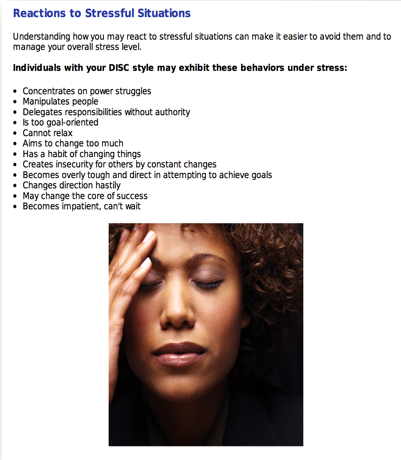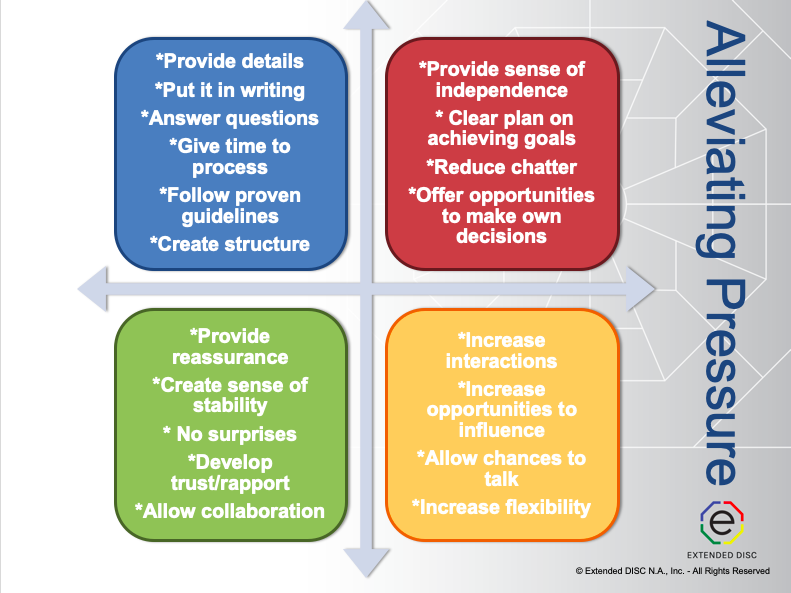Each of our team members perform and relate to others differently under pressure. DISC helps them predict and prepare for more successful outcomes.
Pressure pushing down on me…This is ourselves under pressure…Pressure
– “Under Pressure” by Queen & David Bowie
Queen and David Bowie said it best in their song, ‘Under Pressure‘. Pressure is a situation in which you feel something is at stake and dependent on how you perform. Your goal, when in that pressure moment, is to perform successfully while using all your focus and energy.
Information about pressure is usually easy to find. You can search the internet to find useful tips for managing pressure, but what causes pressure and how we react to it is not the same for everyone. In fact, what may decrease pressure for one team member may actually increase pressure for another. DISC helps us understand how they tend to react in pressure situations so they can be better prepared when it happens; and it will happen.
Overlooking signs of pressure

We overlook signs of pressure until it can no longer be ignored; which is usually too late. When team members feel pressure they do not have the energy and focus to adjust their style; therefore, they tend to revert to their natural behavioral style. Your team members tend to revert to their natural style because it doesn’t take away energy being devoted to handling the pressure. However, what can happen is they tend to overuse the strengths of their style to the point they exhibit the negative aspects of their style.
Reactions to pressure situations are not to be considered weaknesses; rather, they are things your team members should be cautious about. If they are aware of how they tend to react in pressure situations then they can make better decisions about their behaviors by practicing and making adjustments.
Recognizing team members under pressure
 Pressure situations and the symptoms of pressure are not the same for everyone. In fact, some team members may thrive in pressure situations while others try to avoid them and feel depleted of energy.
Pressure situations and the symptoms of pressure are not the same for everyone. In fact, some team members may thrive in pressure situations while others try to avoid them and feel depleted of energy.
D-styles are more likely to feel pressure when they cannot control a situation or perceive inefficiencies. These task-oriented D-styles may react to pressure by becoming easily irritated and overbearing. They may resist your input and ignore authority and rules. On the other hand, I-styles are often stressed by details and structure. They may wilt, become more emotional, and feel overwhelmed by the details.
S-styles are likely to react to behaviors of their team members and conflict. If they feel change is happening too quickly, they may become stubbornly attached to the status quo and look for support. C-styles may feel stressed if there is too much going on, and a lack of clear directions. They may become overly critical or seek the sanctuary of their office.
Helping team members relieve pressures

S-styles and C-styles tend to react positively when their settings are more structured and have a sense of calmness. On the other hand, D-styles and I-styles may feel more pressure in those same settings because they are looking for a more independent and fast-paced setting. The people-oriented I-styles and S-styles, feel pressure when there is too much focus on tasks over interactions and vice versa for the task-oriented D-styles and C-styles.
Try offering D-styles tasks that allow them to shine and opportunities to make decisions. Managers can help them develop their ability to take charge, but with more humility and thought to others. Remember to give positive feedback and attention to your I-styles. Use their positive energy in roles that help boost the team atmosphere. Managers can help them practice more effective reactions to pressure situations by creating more realistic tasks and then working on completing the tasks.
S-styles crave a steady environment with trusted relationships. Managers can try helping them alleviate pressure by giving them information ahead of time and building rapport with them to create a sense of trust. S-styles are more likely to internalize issues so they do not easily show pressure until, it is too late. C-styles can benefit from tasks that allow them to focus without distractions. If you feel your C-style team member is under pressure, make sure you are available for their questions and provide clearer guidelines and time to focus.
Managing pressure for better outcomes
 The DISC assessment describes how your style tends to show up under pressure. It helps predict the behaviors that are present when you encounter pressure situations. Understanding them can help you deal with them and prepare for them. Now you can help your team members avoid the behaviors that may get them into trouble and consider more effective adjustments.
The DISC assessment describes how your style tends to show up under pressure. It helps predict the behaviors that are present when you encounter pressure situations. Understanding them can help you deal with them and prepare for them. Now you can help your team members avoid the behaviors that may get them into trouble and consider more effective adjustments.
Understanding where your team members fall on the DISC model allows for a targeted approach during pressure filled times. Even better, managers and team members can diminish the impact of the pressure if pressure situations are recognized and modified before they occur again. It enables the manager to assign the best and most motivating roles for team members so teams can be more successful.
Pressure is always present, but we can manage our reactions to it
Team members are faced with pressure situations on a daily basis, but they can gain a level of control by understanding DISC styles. When it occurs, they don’t have the energy and focus to rationally consider adjustments. Managers can help them recognize their signs of stress and may even see it before their employees do.
If they are able to recognize their tendencies to behave a certain way under pressure, then they can make decisions on how to better adjust so their reactions to pressure are more effective. In the end, interactions of the team can be improved and accomplishing goals will be more attainable. It’s a win-win for everyone!
Contact us to learn more about our Stress and Pressure Assessments +1.281.298.6073
